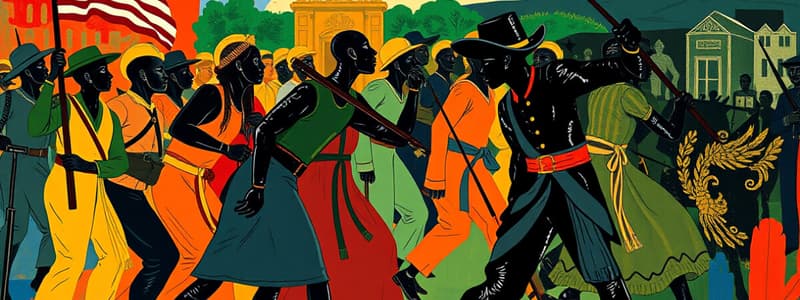Podcast
Questions and Answers
What was the primary economic focus of the southern states after American independence?
What was the primary economic focus of the southern states after American independence?
- Agriculture and plantation crops (correct)
- Technology and innovation
- Manufacturing and industrial production
- Trade and commerce
What type of labor was predominantly used in the southern states' plantations?
What type of labor was predominantly used in the southern states' plantations?
- Skilled workers paid by wages
- Volunteer labor
- Slave labor (correct)
- Prison labor
Which event or movement significantly contributed to the abolition of slavery in the northern states?
Which event or movement significantly contributed to the abolition of slavery in the northern states?
- Industrial Revolution
- Civil Rights Movement
- Expansion of cotton trade
- Anti-slavery movement (correct)
What was one of the main causes of tension between the northern and southern states?
What was one of the main causes of tension between the northern and southern states?
What was a consequence of the harsh treatment of slaves in the USA?
What was a consequence of the harsh treatment of slaves in the USA?
How did the views of the northern states on slavery differ from those of the southern states?
How did the views of the northern states on slavery differ from those of the southern states?
What influence did the potential admission of new states have on the North-South conflict?
What influence did the potential admission of new states have on the North-South conflict?
What was one major characteristic of the industrial revolution in the northern states?
What was one major characteristic of the industrial revolution in the northern states?
What was the primary concern of the Southern states regarding Lincoln's election?
What was the primary concern of the Southern states regarding Lincoln's election?
What action did Lincoln take in response to the attack on Fort Sumter?
What action did Lincoln take in response to the attack on Fort Sumter?
Which event is considered a turning point in the Civil War?
Which event is considered a turning point in the Civil War?
What was one major effect of the Civil War in the United States?
What was one major effect of the Civil War in the United States?
What was Lincoln’s Emancipation Proclamation intended to achieve?
What was Lincoln’s Emancipation Proclamation intended to achieve?
What strategy did Lincoln employ against the Southern ports?
What strategy did Lincoln employ against the Southern ports?
During which event did Lincoln deliver the Gettysburg Address?
During which event did Lincoln deliver the Gettysburg Address?
Which general led the Union forces at the Battle of Gettysburg?
Which general led the Union forces at the Battle of Gettysburg?
What significant policy period followed the Civil War?
What significant policy period followed the Civil War?
What was the stance of Abraham Lincoln regarding the secession of the Southern states?
What was the stance of Abraham Lincoln regarding the secession of the Southern states?
Study Notes
Development of the Northern and Southern States
- Northern states: Includes territories north of Pennsylvania, experienced an industrial revolution between 1815 and 1860.
- Southern states: Comprised areas south of Maryland, primarily agrarian with plantation crops like cotton and tea, reliant on slave labor.
Economic Differences
- Southern economy: Dependent on agriculture and large-scale plantations requiring substantial labor, fulfilled by slaves.
- Northern economy: Characterized by factories, urbanization, and commerce, relying on wage-earning skilled workers, leading to a strong anti-slavery sentiment.
Causes of the American Civil War
Slavery
- Essential conflict stemmed from differing views on slavery; South defended its continuation while the North sought abolition.
- Slaves faced severe restrictions: no property ownership, lack of family rights, and extreme punishment for escape attempts.
Tariff Dispute
- North favored protective tariffs to support local industries, while the South opposed them as they raised prices on imports from the North.
Admission of New States
- Controversy over new states like Texas and California: whether to admit them as free states or slave states escalated tensions.
Lincoln's Election and Southern Secession
- Abraham Lincoln’s election in 1861 prompted fears in the South that slavery would be abolished.
- Eleven southern states seceded from the Union, forming the Confederate States of America.
Key Events of the Civil War
Attack on Fort Sumter
- The Civil War commenced when Confederate forces attacked Fort Sumter in April 1861, prompting Lincoln to declare war.
Union Blockade
- Lincoln established a blockade of Southern ports in April 1861, restricting supplies to the Confederacy.
Emancipation Proclamation
- In 1862, Lincoln issued the Emancipation Proclamation, which freed slaves in Southern states and garnered support for the Union.
Battle of Gettysburg
- Occurred in June 1863, resulted in over 45,000 casualties, marked a turning point in the war with the retreat of Confederate General Robert E. Lee.
End of War and Its Consequences
- General Grant led final attacks against Confederate forces, resulting in Southern surrender in 1865.
- Slavery was abolished nationwide, marking a key outcome of the war.
- The Civil War devastated the Southern economy and infrastructure, necessitating a Reconstruction Period to rebuild.
The Gettysburg Address
- Delivered by Lincoln in 1863, emphasized dedication to the principle of equality and the sacrifices made for national unity, encapsulating the war's moral and political significance.
Studying That Suits You
Use AI to generate personalized quizzes and flashcards to suit your learning preferences.
Description
This quiz explores the differences between the northern and southern states of the USA after gaining independence from Britain in 1776. It focuses on their economic development, agricultural practices, and the use of slave labor in the South. Test your knowledge about this pivotal period in American history.



